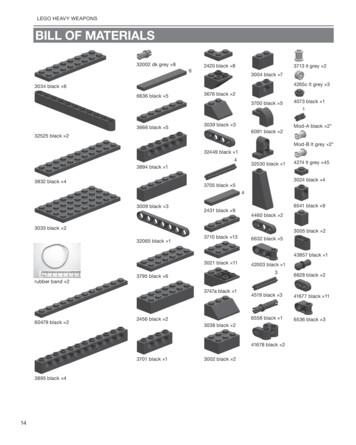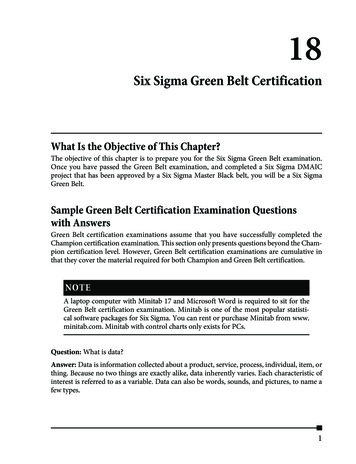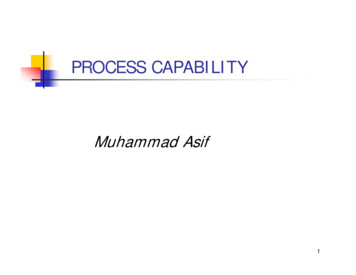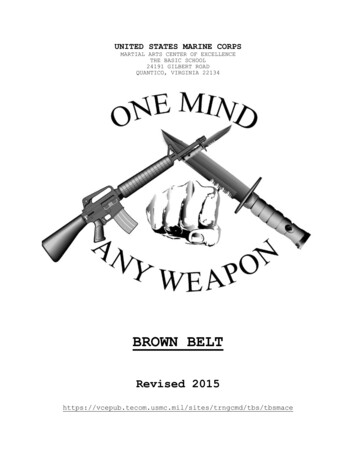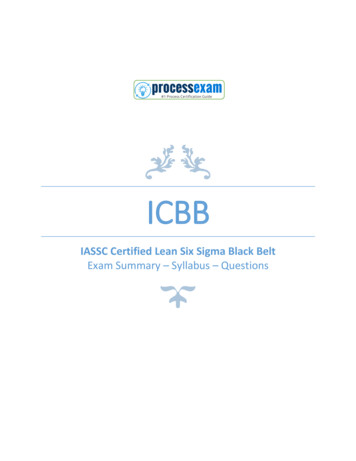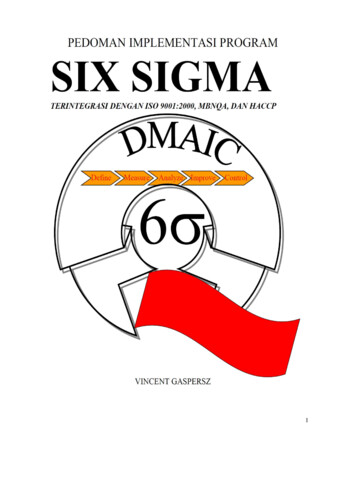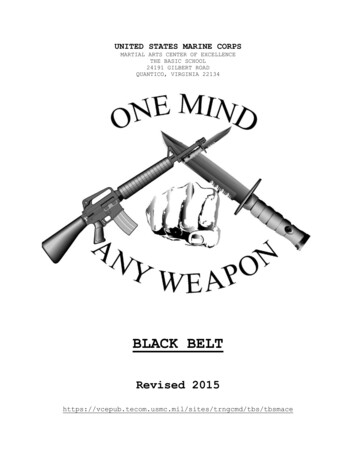
Transcription
UNITED STATES MARINE CORPSMARTIAL ARTS CENTER OF EXCELLENCETHE BASIC SCHOOL24191 GILBERT ROADQUANTICO, VIRGINIA 22134BLACK BELTRevised s/tbsmace
TABLE OF CONTENTSLesson IDLesson TitlePage #MCCS-BLAK-2061BAYONET ROUND FIGHTING.21MCCS-BLAK-2064UNARMED 066COUNTERS TO CHOKES AND HOLDS.45MCCS-BLAK-2067FIREARM DISARMAMENT.55MCCS-BLAK-2068UPPER BODY STRIKES.65MCCS-BLAK-2069KNIFE TECHNIQUES.73MCCS-BLAK-2070WEAPONS OF OPPORTUNITY.87MCCS-BLAK-2071FUNDAMENTALS OF A COMBAT MINDSET.95MCCS-BLAK-2072MASTER OF ARMS.99MCCS-BLAK-2073MARTIAL CULTURE STUDY: THE ZULUS.103MCCS-BLAK-2074FREE SPARRING.111GUIDED DISCUSSION 1:THE ETERNAL STUDENT.119GUIDED DISCUSSION 2:LEADERSHIP TRAITS AND PRINCIPLES.129GUIDED DISCUSSION 3:LEADERSHIP STYLES.143GUIDED DISCUSSION 4:THE WARRIOR ETHOS.153GUIDED DISCUSSION 5:THE ETHICAL WARRIOR.1611
2
MCCS-BLAK-2061UNITED STATES MARINE CORPSMARTIAL ARTS CENTER OF EXCELLENCETHE BASIC SCHOOL24191 GILBERT ROADQUANTICO, VIRGINIA 22134LESSON PLANBAYONET TECHNIQUESMCCS-BLAK-2061BLACK BELTAPPROVED BY:LtCol (Ret) Shusko, J. C.3DATE: 07/10/2015
MCCS-BLAK-2061UNITED STATES MARINE CORPSMARTIAL ARTS CENTER OF EXCELLENCETHE BASIC SCHOOL24191 GILBERT ROADQUANTICO, VIRGINIA 22134INSTRUCTOR PREPARATION GUIDELESSON TITLE:Bayonet TechniquesLESSON DESIGNATOR:MCCS-BLAK-2061TOTAL LESSON TIME:1 hour 30 minutesREFERENCES:MCO 1500.59NAVMC 3500.41MCRP 3-02BPERSONNEL REQUIRED:One instructor and assistantsFACILITIES:Soft footed training areaREVIEW COURSE MATERIALS: Review Lesson PlanADD PERSONALIZATION: Personalize the lesson by adding subject matter detail,personal experiences, examples, and questions.MATERIALS/EQUIPMENT: Rifle/Training Rifle Bayonet Trainer Wooden Bayonet Trainer Flak Jacket Helmet MouthpieceSETUP AND PLANNING: Reserve Training Area Conduct Rehearsals4
MCCS-BLAK-2061INTRODUCTION(5 MIN)1. GAIN ATTENTION. The Eternal Student never stops learning,and never stops becoming something more. He revisits his pastvictories and defeats in order to learn more about himself andthe way he interacts with others. Sometimes the key to a futuresuccess is held within a very small detail that was perhapsmissed as a beginner when everything was new. With this in mindwe will hone our basic skills with a bayonet and integrate theminto a low light environment.2. OVERVIEW. Good morning, my name is . This lessonwill cover bayonet techniques and the eternal student.3.POSITIONSINSTRUCTOR NOTE: Assign demonstration and practice positions.Ensure students have enough space, and can see and hear theinstructor.4.SAFETY.To prevent injury, ensure the following:a.Start slowly and increase speed with proficiency.b.Never execute techniques at full force or full speed.c.Training will be conducted in three stages.(1) Marines will execute techniques in the air.(2) Marines will practice strikes on a pad or dummy.(3) Marines will practice during free sparring.d.Before training with firearms, unload and show clear.e.When handling firearms, the weapons safety rules apply.(1) Treat every weapon as if it were loaded.(2) Never point a weapon at anything you do not intendto shoot.(3) Keep your finger straight and off the trigger untilyou are ready to fire.(4) Keep your weapon on “safe” until you intend to fire.5
MCCS-BLAK-2061f. Conduct all practical application utilizing approvedtraining gear.TRANSITION. Now that you know what will be covered are thereany questions? Let’s discuss the purpose of bayonet techniques.BODY1.(70 MIN)EXPLAINa. Purpose. The purpose of bayonet techniques is todisable or kill an aggressor.b. Principles. The principles for bayonet techniques aremindset, grip, stance, movement, and channeling. We will alsoapply the principles of a low light environment.(1) Mindset. When engaged, your mindset is a factor ofsuccess or failure. Mindset is the "mental trigger" during adefining moment that enables you to commit to an attack. Youmust have the superior mindset against the aggressor to succeed.(2) Grip. It is possible to execute these bayonettechniques while gripping the buttstock of the weapon, but thestress is on being able to execute them from the pistol grip.These are lethal, offensive techniques that can be used inconjunction with assault fire movement.(a) Grab the pistol grip with your right hand. Keepyour trigger finger off the trigger and included it in the grip.(b) With the left hand, grab the hand guards of therifle under-handed.(c) Lock the buttstock of the rifle against the hipwith the right forearm.(d) Keep movements of the bayonet blade within abox, shoulder width across from your neck down to yourwaistline. Always keep the bayonet end of the rifle orientedtoward the aggressor.(3) Stance. All movement begins and ends with themodified basic warrior stance. Create a smaller silhouette andlower center of gravity by lowering your body at the knees andcreate “eye-muzzle-target” toward the aggressor.(4) Movement. Movement is used to get from one place toanother when the threat of contact is imminent. Use a6
MCCS-BLAK-2061controlled and steady combat glide to avoid tripping whilemoving toward the aggressor.(5) Channeling. Channeling is using movement to placeone aggressor in front of the other. This will allow you toengage one aggressor at a time. Using the proper angles ofapproach learned earlier in your martial arts training doesthis.(6) The Low Light Environment. You can see much more inthe dark than you realize. Using your eyes effectively at nightrequires the application of the principles of night vision: darkadaptation, off center vision, and scanning.(a) Dark Adaptation. Dark adaptation is allowingyour eyes to become accustomed to low levels of illumination. Ittakes about 30 minutes for you to be able to distinguish objectsin dim light. Red light is used so as not to destroy your nightvision.(b) Off-Center Vision. Off-center vision is thetechnique of keeping your attention focused on an object withoutdirectly looking at it. When you look directly at an object,the image is formed on the cone region of your eye, which is notsensitive at night. When you look slightly off center (optimumis usually six to ten degrees) of an object, the image is formedon the area of your retina containing rod cells, which aresensitive in darkness.(c) Scanning. Scanning is using off center visionto observe an area or an object. When you use rod vision thecells being used black out after four to ten seconds and theobserved object disappears. You must shift your eyes slightly sofresh rod cells are used. This is accomplished by moving youreyes in short, abrupt, irregular movements over and around yourtarget.c. Fundamentals. The fundamentals for bayonet techniquesare approach, close, and entry.(1) Approach. Approaching is used when you have locatedthe aggressor. While maintaining a combat glide, move towardthe aggressor until you are within 5 to 10 feet. The bayonetmust stay locked on the aggressor.(2) Close. As you reach the critical distance of 5 to10 feet, you will use a burst of speed to close the finaldistance with the aggressor. Increase your speed by quickeningyour steps without changing your stride length or standing7
MCCS-BLAK-2061upright. This will cause the aggressor to hesitate and give youthe psychological and tactical advantage.(3) Entry. The entry is made to get inside theaggressor’s defense to conduct a lethal attack. The movementcan be a step forward or to an oblique to get within range.(a) Target Areas. The primary target areas of thebody are the aggressors throat, groin, or face. The aggressor’storso can be another target area if it is not protected by bodyarmor.(b) Striking Surface. Thrusts will use the point ofthe bayonet and slashes will use the cutting edge of thebayonet. Buttstrokes will use the toe of the buttstock off therifle and smashes will use the butt of the rifle.TRANSITION: We have covered the purpose, principles, andfundamentals, are there any questions? We will now beginpractical application.2.DEMONSTRATEINSTRUCTOR NOTE: There is no demonstration.conducted in stages.3.Training will beIMITATEINSTRUCTOR NOTE: There is no imitation. Training will beconducted in stages to re-focus the basic principles andfundamentals before conducting the low light engagements.a. Stage One. This stage focuses on developing theMarine’s static techniques in a low light environment. Marineswill practice the principles and fundamentals and the individualbayonet techniques from tan belt. Ensure Marines are proficientbefore moving to stage two.b. Stage Two. This stage will incorporate movement againstaggressors in a low light environment. Marines will practicethe bayonet techniques from gray, green, and brown belt. EnsureMarines are proficient before moving to stage three.c. Stage Three. This is the final stage of low lighttraining. Marines will practice bayonet techniques in a dynamicenvironment against resisting aggressors. Marines will executeone on one engagements and engagements against multiple8
MCCS-BLAK-2061aggressors. The training may be tailored to the individualinstructor, unit, and terrain.4.PRACTICEINSTRUCTOR NOTE: Fault check student proficiency and safety.TRANSITION: We have learned bayonet techniques, are there anyquestions? We must continue to train and develop our skills asan eternal student.5.TIE IN (THE ETERNAL STUDENT)a. As stated in his Commandant’s Guidance (ALMAR 023-99),General Jones believes that PME not only causes Marines toexperience personal and professional growth, but also increasestheir self-worth and productivity.b. The development of a Marine leader is never ending. TheMarine Corps envisions four elements, or pillars, of leadershipdevelopment:(1) First is education, the development of a creativemind that has the ability to question, to reason, and to thinkunder pressure and to successfully lead Marines in combat.(2) Second is training, which is usually performancebased and measured against a standard. For Marines, trainingwill dominate the early part of their career; however, Marinesnever stop training.(3) Third is experience; the knowledge based on day-today events that occur throughout life.(4) Fourth is self-development, the individualcommitment to the profession of arms through activities asprofessional reading and off-duty education.c. Life Long Learning Programs. The Marine Corps’ LifeLong Learning Program’s mission is to provide a variety ofworld-class educational programs offering opportunities thatinspire and prepare Marines with career progression, enlightenand strengthen the Corps’. Life Long learning will providegoals for the Marine Corps Community and guide them into thenext century by assisting in the development of the “TotalMarine”. Some of these programs include: the Tuition AssistanceProgram, Dante’s Examination Program, Military Academic Skills9
MCCS-BLAK-2061Program, the G.I. Bill, the U.S. Military Apprenticeshipprogram. The Lifelong Learning Programs Branch (MRV) atHeadquarters Marine Corps is guided by DOD Directive 1322.8 toprovide programs for the following areas: Adopt-A-School Program.Afloat Education Program.United Services Military Apprenticeship Program (USMAP).Defense Activity for Non-Traditional Education Support(DANTES).School Age Family Member Program.Library Programs.Marine Corps Satellite Education Network (MCSEN).Military Academic Skills Program (MASP).Military Installation Voluntary Education Review (MIVER).Military Tuition Assistance (TA).Montgomery GI Bill (MGIB).Joint Service Transcript (JST).Service members Opportunity Colleges Marine Corps (SOCMAR).Spouse Tuition Assistance (TA).d. Marine Corps Professional Reading Program. The purposeof the Marine Corps Professional Reading program is to encourageMarines to read books that have a direct relationship to warfighting. We will do this by issuing the Commandant’s intent onprofessional reading in ALMAR 246/96 and the list by MCBUL 1500.(1) In an era of constrained resources, our professionalreading program is designed to provide Marines with anintellectual framework to study warfare and enhance theirthinking and decision making skills. The mind, like the body,grows soft with inactivity. All Marines must understand thatmental fitness is as demanding and as important as physicalfitness, as both require commitment and perseverance. In aworld characterized by rapid change and great uncertainty, ourreading program will act as a combat multiplier by providing allMarines with a common frame of reference and historicalperspective on warfare, human factors in combat and decisionmaking. In so doing, the program will also strengthen thethreads of cohesion that make our Marine Corps unique.(2) The CMC reading list, issued as MCBUL 1500,establishes the framework for professional reading. Valuableperiodicals include the Marine Corps Gazette, the NavalInstitute Proceedings, and Military Review.10
MCCS-BLAK-2061(3) As part of our overall professional militaryeducation program, I encourage Marines to comply with theguidelines established in the reading list. We have no moreimportant responsibility to the American people than to be readyto fight and win our nation’s battles. Education is critical—perhaps central—to this ability. Our professional readingprogram will help us to achieve this.e. Being and Becoming. There are many discussions on thistopic available for your personal use, each with their ownconnotations, depending on their frame of reference. We willdiscuss them from our own perspective, with an understandingthat this concept reaches far beyond the scope of our limiteddiscussion.(1) Being is a stagnant notion. It evokes a view thatone has accomplished everything there is to do for one’s stationin life. It does not allow room for growth. We generally findthose that feel they have arrived, as egotistical or arrogant.They are unable to move past the things they do not know,because they have determined that they already have all of theinformation they need to reach a decision. Their ways oftraining become less proficient. If we feel that we have becomesomething, then there is no reason to continue striving for it.We stop growing and often slide into a state of disrepair, wherewe are nowhere near where we think we are.(2) Becoming is a dynamic state, which allows forlimitless growth. When we exist in this state we do not limitourselves, or become so defined by our past accomplishments.Marines that are always becoming are not threatened by new waysto accomplish the mission, because they are open to the ideasthat they have not come across yet. They are not easilydefeated, as they are able to take in new information, adapt toa changing environment, and overcome the challenges of theirenemies.TRANSITION: We have discussed the eternal student, are thereany questions?SUMMARY(10 MIN)During this period of instruction we have covered bayonettechniques and the eternal student. I am now confident you willbe able to use these techniques to kill the enemy if necessary.INSTRUCTOR NOTE: Provide follow-on instructions.11
MCCS-BLAK-206112
MCCS-BLAK-2062UNITED STATES MARINE CORPSMARTIAL ARTS CENTER OF EXCELLENCETHE BASIC SCHOOL24191 GILBERT ROADQUANTICO, VIRGINIA 22134LESSON PLANTHROWSMCCS-BLAK-2062BLACK BELTAPPROVED BY:LtCol (Ret) Shusko, J. C.13DATE: 07/21/2015
MCCS-BLAK-2062UNITED STATES MARINE CORPSMARTIAL ARTS CENTER OF EXCELLENCETHE BASIC SCHOOL24191 GILBERT ROADQUANTICO, VIRGINIA 22134INSTRUCTOR PREPARATION GUIDELESSON TITLE:ThrowsLESSON DESIGNATOR:MCCS-BLAK-2062TOTAL LESSON TIME:1 hourREFERENCES:MCO 1500.59NAVMC 3500.41MCRP 3-02BPERSONNEL REQUIRED:One instructor and assistantsFACILITIES:Soft footed training areaREVIEW COURSE MATERIALS: Review Lesson PlanADD PERSONALIZATION: Personalize the lesson by adding subject matter detail,personal experiences, examples, and questions.MATERIALS/EQUIPMENT: MouthpieceSETUP AND PLANNING: Reserve Training Area Conduct Rehearsals14
MCCS-BLAK-2062INTRODUCTION(5 MIN)1. GAIN ATTENTION. In any combat situation, sizes andstrengths of your enemy will vary. Marines will never have theopportunity to choose their enemies on the battlefield and willneed the skills to handle any situation with any aggressor. Bythe end of this period of instruction you will be able to gain atactical advantage on your aggressor using the black belt throwsand have a better understanding of the leader/followerrelationship in the Corps.2. OVERVIEW. Good morning, my name is . This lessonwill cover throws and the concept of the leader and thefollower.3.POSITIONSINSTRUCTOR NOTE: Assign demonstration and practice positions.Ensure students have enough space, and can see and hear theinstructor.4.SAFETY.To prevent injury, ensure the following:a.Start slowly and increase speed with proficiency.b.Never execute techniques at full force or full speed.c.Techniques will be performed on a soft-footed area.d.Students being thrown will execute proper break falls.e. Practice fit-ins when learning throws. To execute afit-in, stop just before throwing the aggressor to the deck.TRANSITION. Now that you know what will be covered are thereany questions? Let’s discuss the purpose of throws.BODY1.(45 MIN)EXPLAINa. Purpose. The purpose of a throw is to bring anaggressor to the deck to gain the tactical advantage in a fight.b. Principles. The principles for throws are balance,leverage, timing, and body position.(1) Balance. It is important to maintain control ofyour balance to prevent the aggressor from countering the throw.15
MCCS-BLAK-2062(2) Leverage. You will use the aggressor’s body as alever to increase the power generated for the throw. Leveragewill allow you to throw any aggressor of any size.(3) Timing. All throws must be properly timed to attackthe aggressor when they are off-balance and vulnerable.(4) Body Position. You must put your body into aposition that is optimal for the throw. If your position isincorrect, the aggressor can counter the throw.c. Fundamentals. The fundamentals for throws are entry,off-balance, and execution.(1) Entry. The first part of a throw is the entry.Your entry should be quick and un-telegraphed to prevent theaggressor from anticipating your movement and countering yourattack. You also want to make sure your body positioning iscorrect in relation to your aggressor to allow for proper offbalancing and execution of the throw.(2) Off-Balancing. The second part of a throw is offbalancing. Off-balancing techniques are used to control anaggressor by using his momentum to move or throw him. This aidsin the execution of throws because your aggressor is unable tofight your attack with his full strength when he is offbalanced.(a) Angles of Off-Balancing. There are eight anglesor directions in which an aggressor can be off-balanced:forward, rear, right, left, forward right, forward left, rearright, and rear left. The angles correspond to yourperspective, not the aggressor's.(b) Off-Balancing Techniques. An aggressor can beoff-balanced by pushing, pulling, or bumping. Pushing andpulling are performed by grabbing the aggressor with your handsand driving him forcefully to one of the angles of offbalancing. Bumping uses other parts of your body such as yourshoulders, hips, and legs to off-balance the aggressor.(c) Momentum. Off-balancing techniques rely on themomentum of the aggressor. For example, if the aggressor ischarging at you, you can pull him to drive him to the deck.Likewise, if the aggressor is pulling on you, you can push himto drive him to the deck. Using momentum is particularlyeffective for Marines who are outsized by the aggressor.16
MCCS-BLAK-2062INSTRUCTOR NOTE: Students may practice off-balancing.students do not to drive the aggressor to the deck.Ensure(3) Execution. The third and final part of a throw isthe execution. The remaining steps in throwing the aggressor tothe deck are utilized here. Each step before this is just toset up and assist in this final process. Follow through thethrow to maximize power.TRANSITION: We have covered the purpose, principles, andfundamentals, are there any questions? I will now demonstratethe first technique.2.DEMONSTRATEINSTRUCTOR NOTE: Demonstrate only one technique at a time.Do not explain the steps or open the class for questions.INTERIM TRANSITION:3.Go to practice position one.IMITATEa. Sweeping Hip Throw. A sweeping hip throw is used if theaggressor widens his stance to prevent you from executing thehip throw.(1) Start facing the aggressor in the basic warriorstance.(2) Grasp the aggressor's right wrist with your lefthand and step in between his feet with your right foot.(3) Rotate on the ball of your right foot and bring yourleft foot inside the aggressor’s feet. Your heels should betogether and your knees should be bent.(4) At the sameback of the aggressor’sbackside and hip shouldaggressor’s hips and intime, hook your right arm around thebody and pull him in close to you. Yourbe lower than and outside youra position of leverage.(5) Pull your aggressor’s right arm across your body andslightly lift the aggressor off the deck by bending at thewaist, straightening your legs, and rotating your body to yourleft. If the aggressor cannot be easily lifted, your bodyposition is incorrect.17
MCCS-BLAK-2062INSTRUCTOR NOTE: Have the students practice fit-ins as manytimes as necessary to become proficient.(6) Once your aggressor starts to come off the deck,forcefully sweep his upper right thigh back with your right leg.(7) Drive the aggressor to the deck by forcing him overyour hip and following through with the throw.(8) Rapidly return to the basic warrior stance.4.PRACTICEINSTRUCTOR NOTE: Fault check student proficiency and safety.TRANSITION: We have learned throws, are there any questions?Every Marine must also an effective leader and follower.5. TIE-IN (THE CONCEPT OF THE LEADER AND THE FOLLOWER). Aleader is defined as "one who or that which leads." A followeris defined as "one in service of another, one that follows theopinions or teachings of another, or one that imitates another."In the Marine Corps, this leader-follower is discussed assenior-subordinate relations. Many join the Corps to be leadersof Marines, but we must remember all leaders are also followersof someone else. Thus, we come into the Corps to be leaders-and we continuously talk about, read, and discuss leadership-but the follower part, or follower-ship, is often overlooked.a. Follower. Follower-ship must be an integral part of ourphilosophy, for it is the base upon which future leaders aretempered and its enhancement among subordinates will ensure thatprofessionalism is keyed at all levels--followers, as well asleaders.(1) We spend most of our formative years in following(and demonstrating signs of leadership) and though we study andtry to abide by the leadership principles, we tend to copy thestyle and methods used by former leaders. We pick out someleader, or the strong points of several leaders whom we havefollowed, and try to emulate them. Marines can also learn whatnot to do by observing poor leaders. In theory, if a followercould acquire a combination of the good features they haveobserved in their leaders, they would command the qualities ofthe ultimate leader. So there is a very close relationshipbetween leadership and follower-ship.18
MCCS-BLAK-2062(2) The follower must have a personal commitment to thesuccessful completion of his mission or assigned task. The mosteffective follower is the one who accepts the necessity forcompliance and who is committed to placing the needs of othersabove his own. Dedication is a commitment to a system or ideal.It is the vehicle of self-discipline, competence,responsibility, and professionalism; it is the follower'sguideline. Leaders are useless without followers, and followersare useless without leaders.(3) The most effective follower is that individual whohas proven leadership abilities and who is loyal, dependable,obedient, and dedicated to uphold their responsibilities andperform their duties to the best of their ability as well asexert positive influence upon their fellow Marines.b. Leader. Leaders must treat their followers as Marinesand as individuals. Marines stripped of their dignity,individuality, and self-respect are destined to mediocrity andare potential "problems." The leader must ensure that what isbest for the many can be achieved without cramping the lifestyle or withering the individuality and initiative of those whofollow. Leaders can achieve loyalty, obedience, and disciplinewithout destroying independence.(1) The leader must realize each Marine is a uniqueindividual and that it is natural to treat each one differently.The leader who claims: "I treat all my Marines alike," isconfusing leader-follower relations. Leadership relations withall followers should be consistent (i.e., fair, firm,understanding, etc.); their policies must not fluctuate (allshoes will be shined daily and everyone will have a regulationhaircut); their actions should be reasonably predictable totheir followers, who must know what is expected of them. TheMarine from the Bronx who comes from a broken home, however, isdifferent from the Marine from a Kansas farm with close knitfamily ties--the leader will find it most difficult to counsel,communicate with, or otherwise treat these Marines alike.(2) Most Marines expect and seek tough training or theywouldn't have joined in the first place; but Marines can betougher, perform better in garrison, and fight harder in combatif their leaders show they care. Making Marines feel theybelong and treating them with dignity and respect makes themfeel important and valuable.c. The philosophy of the leader and follower is based uponthe concept that there should exist a “spirit of comradeship inarms" between seniors and subordinates in the Corps. This19
MCCS-BLAK-2062mutual understanding of their roles as the senior and thesubordinate establishes the "Brotherhood/Sisterhood of Marines."As part of this unique bond, each Marine shares the commonexperience of depending upon fellow Marines for accomplishingthe mission. The senior-subordinate relationship is based on amutual trust and understanding and thrives on trust andconfidence.INSTRUCTOR NOTE: Instructors may enhance this tie-in withadditional material in Appendix A, Guided Discussion 2.TRANSITION: We have discussed the concept of the leader andfollower, are there any questions?SUMMARY(10 MIN)During this period of instruction we have covered throws and theconcept of the leader and the follower. I am now confident youwill be able to use these techniques to gain the tacticaladvantage in a fight.INSTRUCTOR NOTE: Provide follow-on instructions.20
MCCS-BLAK-2063UNITED STATES MARINE CORPSMARTIAL ARTS CENTER OF EXCELLENCETHE BASIC SCHOOL24191 GILBERT ROADQUANTICO, VIRGINIA 22134LESSON PLANGROUND FIGHTINGMCCS-BLAK-2063BLACK BELTAPPROVED BY:LtCol (Ret) Shusko, J. C.21DATE: 08/10/2015
MCCS-BLAK-2063UNITED STATES MARINE CORPSMARTIAL ARTS CENTER OF EXCELLENCETHE BASIC SCHOOL24191 GILBERT ROADQUANTICO, VIRGINIA 22134INSTRUCTOR PREPARATION GUIDELESSON TITLE:Ground FightingLESSON DESIGNATOR:MCCS-BLAK-2063TOTAL LESSON TIME:1 hour 45 minutesREFERENCES:MCO 1500.59NAVMC 3500.41MCRP 3-02BPERSONNEL REQUIRED:One instructor and assistantsFACILITIES:Soft footed training areaREVIEW COURSE MATERIALS: Review Lesson PlanADD PERSONALIZATION: Personalize the lesson by adding subject matter detail,personal experiences, examples, and questions.MATERIALS/EQUIPMENT: MouthpieceSETUP AND PLANNING: Reserve Training Area Conduct Rehearsals22
MCCS-BLAK-2063INTRODUCTION(3 MIN)1. GAIN ATTENTION. Anything is possible on the battlefield andif you should end up fighting an aggressor on the ground, youmust be prepared for it. Ground fighting techniques will allowyou to fight and aggressor and get back to your feet. Maneuverwarfare is another technique that gives is a tactical advantageover our enemy.2. OVERVIEW. Good morning, my name is .will cover ground fighting and citizenship.3.This lessonPOSITIONSINSTRUCTOR NOTE: Assign demonstration and practice positions.Ensure students have enough space, and can see and hear theinstructor.4.SAFETY.To prevent injury, ensure the following:a.Start slowly and increase speed with proficiency.b.Never execute techniques at full force or full speed.c.Techniques will be performed on a soft-footed area.d. Apply slow, steady pressure until the aggressor tapsout. Aggressor will tap out when they become uncomfortable.They may tap the deck, tap themselves, tap the Marine, orverbally say “tap-tap-tap.” The Marine must immediately releasethe pressure when the aggressor taps out.TRANSITION. Now that you know what will be covered are thereany questions? Let’s discuss the purpose of ground fighting.BODY1.(90 MIN)EXPLAINa. Purpose. The purpose of ground fighting is to get backto your feet as quickly as possible.b. Principles.space and control.The principles for ground fighting are(1) Space. Create space in order to execute techniquesthat will disable the aggressor allowing you to get back to yourfeet. Too much or too little space can give the aggressor theadvantage.23
MCCS-BLAK-2063(2) Control. Control the aggressor in order to limithis movement and ability to damage you. Take away theaggressor’s space to reduce his ability to fight.c. Fundamentals. The fundamentals for ground fighting arethe mount position and guard
mindset, grip, stance, movement, and channeling. We will also apply the principles of a low light environment. (1) Mindset. When engaged, your mindset is a factor of success or failure. Mindset is the "mental trigger" during a defining moment that enables you to commit to an attack. You must have the superior mindset against the aggressor to .


